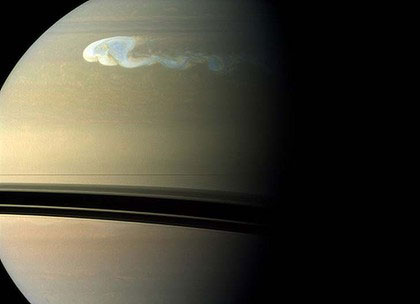The storm with lightning on Saturn releases tremendous heat
The biggest and most intense storm in the last 20 years has been discovered on Saturn. The initial measurement data for the storm was published on the cover of Nature , July 7, 2011.
This is an additional highlight for the FWF project that has been around for 2 years, with funding from the Austrian Science Foundation. The FWF project focused on analyzing data collected from NASA's Cassini Space probe ship. However, this latest storm is attracting the attention of amateur astronomers around the globe. Because, according to scientists' calculations, the storm released about 1 million powers 7 (units of heat (j)). Furthermore, measurements provide support for a hypothesis that predicts Saturn storms occur seasonally .

This is not a beautiful day on Saturn: A giant storm
growing in the northern hemisphere (Photo: NASA)
Other planets also have very unusual weather. Currently, the Space Research Institute of the Austrian Academy of Sciences is focusing on investigating the likely seasonal storms on Saturn. The goal of the FWF project is to focus on measuring Saturn's atmospheric electricity. The project started in August 2009, in the plan to analyze an old thunderstorm at a level of detail. However, this work continues until December 5, 2010.
On that day, a tool to measure radio and plasma waves on NASA's Cassini probe detected the first bolt of a storm forming in Saturn's northern hemisphere. No one thought that this would be the biggest storm Cassini had ever measured on Saturn, because the first photographs taken by the system were also used to take scientific photographs on the Cassini space probe, showing 1 small, bright cloud. This image has even been picked up by accident, according to Dr. Georg Fischer, head of the FWF project and the lead author of the paper published in the cover of Nature , explains: " It is impossible to control. The camera follows your mood, this is an accidental coincidence: the ability of the camera to point in the right direction at the right time, will take time to analyze these photos, so I immediately sent I asked them to help amateur astronomers around the globe, I asked them to observe the thundercloud cloud, on specific lightning strikes, to analyze it together accurately. "
This quick reaction worked, making it possible for us to follow the strong development of the storm, explained Dr. Fischer: " Three weeks after the storm was discovered, it expanded more. 10,000 km Two months later, it encompasses the entire planet, and now, 7 months after its discovery, it covers an area of 4 billion square kilometers, equal to 8 times the surface area of the Fruit. land. "

(Artwork: NASA)
An important part of the FWF project is the measurement of lightning activities thanks to the help of radio waves . This radio wave, also known as Saturn Electrostatic Discharge (SEDs), usually occurs in a short time, emitting distinct waves. But in this case, it is very different, the sequence of individual lightning bolts is so fast that radio waves are continuously emitted just to measure it. Sometimes up to ten lightning bolts per second. Combining all these lightning operations, the storm achieves full energy of about 1 million powers 7 (or 10 powers of 24 (j)) in the first 3 months of the storm, corresponding to the total Annual solar energy comes to Earth.
Dr. Fischer said: The size of the storm is as impressive as the time and location of the storm: " Cassini space probe has been observing Saturn since 2004, and in the period this time, thunderstorms were observed only in the southern hemisphere of Saturn, and 1 year in Saturn was 29.5 years on Earth, and August 2009 began in the spring of Saturn. It was hypothesized that the thunderstorm would turn to the northern hemisphere of Saturn, and the events that took place in the present short time, supported this hypothesis, I was really surprised. Success for our FWF project. "
- Saturn lightning storm breaks the record in our solar system
- How does lightning kill people?
- Tin latest storm No. 3: Lightning storms landed in Hai Phong - Ninh Binh
- Extreme picture of super typhoon on Saturn
- At the moment when lightning struck the sailboat, it created a fireball
- Learn about lightning - the deadly beauty of nature
- 1000 tons of diamonds poured down on Saturn and Jupiter every year
- He suffered 70,000 lightning strikes in just 2 days
- Hurricane No. 3, level 14, is approaching Quang Ninh - Thanh Hoa
- Spot the 'storm' on Saturn
- Video: The rain of diamonds on Saturn is amazing
- Overview of Saturn
 Van Allen's belt and evidence that the Apollo 11 mission to the Moon was myth
Van Allen's belt and evidence that the Apollo 11 mission to the Moon was myth The levels of civilization in the universe (Kardashev scale)
The levels of civilization in the universe (Kardashev scale) Today Mars, the sun and the Earth are aligned
Today Mars, the sun and the Earth are aligned The Amazon owner announced a secret plan to build a space base for thousands of people
The Amazon owner announced a secret plan to build a space base for thousands of people